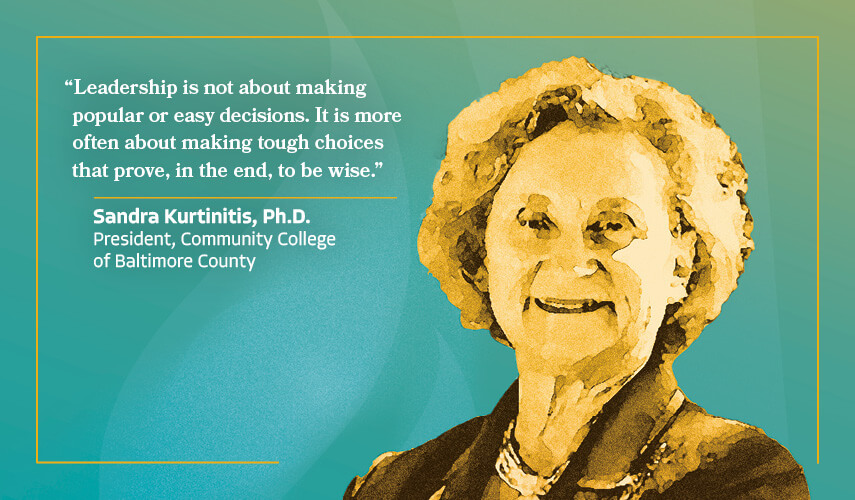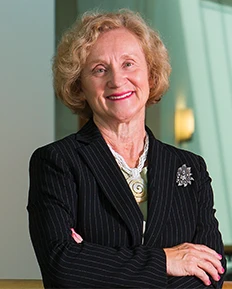
Courageous Leadership
The Courage to Reconnect
By Sandra L. Kurtinitis, Ph.D., President, Community College of Baltimore County (MD)
In 1998 the Board of Trustees of the three community colleges of Baltimore County made the difficult decision to create one college out of the three independent institutions. When I arrived in 2005 as the fifth chancellor of the Community College of Baltimore County (CCBC) in its short life span of seven years, I quickly realized that achieving this goal without radical change would be a challenge. Faculty and staff were disoriented and unhappy, and the new institution still had three of every policy, position, and process.
Although the college was too small to be a “system,” its executive structure of chancellor, multiple vice chancellors, and three independent campus presidents was not aligned with the needs of the new college. College leadership was far removed from the daily rhythms of life and learning on the campuses. This disconnect not only isolated the leadership team from the staff but also hindered collaboration between the campuses, leaving CCBC fragmented and in need of greater cohesion.
Leadership is not about making popular or easy decisions. It is more often about making tough choices that prove, in the end, to be wise.

Sandra L. Kurtinitis
Ph.D., President, Community College of Baltimore County (MD)
Having already served for ten years as a president experienced in leading a college with multiple sites, I knew the power of unified leadership to provide one clear vision and one strong voice. I also knew my leadership style was not about sitting in an office and sending messages down the chain. Having been an English professor for 22 years, I needed to be on the ground, engaging directly with faculty, staff, and students. These personal connections, along with an understanding of the everyday experience of front-line professionals serving and supporting students, both in and out of the classroom, prompted me to consider a vastly different leadership model for my new college.
Within a month of arrival, I proposed to the Board a new organizational structure designed to dismantle the college’s hierarchical leadership levels. In short, I would demote myself from chancellor to president and replace a 15-member executive team with four traditionally focused vice presidents: Administration, Academic Affairs, Enrollment, and Advancement. It was a bold move, but one which the trustees were willing to support.
While this massive change shocked some, many more were heartened by it. A flattened leadership structure made a strong statement about forging a partnership between a newly minted “boots on the ground” executive team along with faculty and staff. All of us would recommit to our open-door mission and together make support for our students Job #1!
Fostering a Culture of Connection
With the Board’s support of this restructuring plan, the cultural shift within our college community was immediate, strengthening connection across the campuses. Rather than excluding faculty and staff from transformational conversations, we engaged them, illustrating the strength of leadership at every level. We rallied around a central theme: “The power of one, built on the strength of three!” Translation: one great college built from the combined strength of three fine institutions. No matter the role each of us played at the institution, we bonded around the need to build a strong collegewide model designed to support all students with a single set of policies, procedures, and organizational structures. Real leadership in the community college world is never about impressive titles and fancy office suites. Our job satisfaction comes from our dedication to our “open door” mission. Not only do we love it, we live it! Leadership is not about making popular or easy decisions. It is more often about making tough choices that prove, in the end, to be wise.
That same philosophy guided us through one of the greatest challenges we have faced as an institution-the COVID-19 pandemic. Like every other educational institution, we shut down our campuses in March 2020 when Governor Hogan ordered mandatory closure of all Maryland schools, colleges, and universities. We moved to a virtual universe as quickly and efficiently as we could. By April, however, a devastating saga had begun to unfold before our eyes as 4,200 students—out of the 15,000 registered for the Spring semester—withdrew…and we quickly figured out why.
The Courage to Act
CCBC’s demographics show that 85% of our students are low-income or minority and come from economically challenged communities. Most of these students, therefore, had no Wi-Fi, no technology, and no skill to enter a digitized world. This crisis quickly showed us that our mission now was not just about delivering education; it was about ensuring equity in access to education. In this time of crisis, a new challenge presented itself and a new commitment emerged. Too many students had already slipped through the cracks, and we were determined to find a way to ensure that no one who came to us seeking educational opportunity—computer literate or not—would be left behind.
By May, we reached a critical decision. We would not simply protect ourselves from COVID by hiding behind a virtual wall while students unfamiliar with a virtual world simply disappeared. I challenged my leadership team to join me in an effort to keep our campuses fully open to serve these students, and they, without hesitation, said, “Yes.” So, while 80% of our 50,000 students continued to study online, the other 20% (roughly 8,000-10,000 students who would otherwise have quietly disappeared during those COVID years) were able to sit in “covidized” on-campus classrooms to continue their education.
We reopened our campuses and set to work. By Fall semester, 30% of all classes offered at CCBC were onsite with class sizes reduced to 8-10 students to ensure social distancing. We created a financial model to maximize college, state, and federal relief funds to create a Tuition Free program to support nearly all of our students as well as to purchase tens of thousands of masks, COVID tests, and other equipment necessary to fight COVID. We held COVID shot and test clinics in gymnasiums and installed huge air filters everywhere. Faculty, clad in protective gear resembling spacemen, volunteered to teach in classrooms across all three campuses as did professional and classified staff in major service areas. In addition, we expanded Wi-Fi access to parking lots and outdoor spaces as well as opened large computer centers on all campuses to ensure access to those who had no technology or study space at home.
None of this was easy, and there were many moments when the magnitude of the task felt overwhelming. We followed every state regulation to the letter to achieve the support we needed. As grueling and challenging as this two-year saga was, all of us at CCBC take rightful pride in our accomplishment. The commitment of faculty and staff during this time was little short of inspiring. We forced no one to return to campus during those dark days, but plenty of volunteers stepped forward to do so. Whether on campus or online, CCBC faculty and staff kept teaching, supporting, and guiding students through one of the most difficult times we have experienced as an institution.
For us at CCBC, the pandemic was not only hard work; it was “heart work.” Because of the courage and dedication of our college community, thousands of students continued their education. And the business side of this equation also brought positive news. Remaining fully open during the pandemic meant that CCBC’s enrollment decline dipped only to the minus 7% range rather than minus 20+% experienced by so many of our colleagues.
The Heart of Leadership
This experience reinforced something I have always believed: leadership is not about making only popular decisions; it is about responding to circumstances to make the right decisions. It is about having the courage to act when the stakes are high, and lives are impacted. At the core of CCBC’s leadership philosophy is the image of drawing circles that pull people in rather than building walls to keep them out. It is about creating a sense of community where every voice is heard and valued as well as finding ways to insist that laughter and lightheartedness are not forgotten. We had found ways to stay connected with our sprawling community of 3,000 employees stretched across 8 sites. I held weekly “Desk-Side Chats” from my office computer to share information with the college community as well as to keep us connected. Throughout the pandemic, we continued to conduct our regular business both virtually and onsite: holding college-wide forums, leadership meetings, academic school meetings, etc. in virtual format. We made silly videos to keep spirits up and found ways to hold special events like Commencement, our annual Gala, student town halls, etc. rather than cancelling them. We made sure that everyone knew what was happening; understood why decisions were being made; and could count on the college to support them. None of these measures was solely about keeping people informed; they were intended to remind all of us that we were all in this together.
I am proud to say that CCBC’s challenging origin is now a fact of history. Our college has matured into a powerhouse in our region and our state. We served 51,600 students last year in over 300 credit and continuing education programs. By year’s end, nearly 13,000 of them completed something important to themselves and their families: a degree, certificate, transfer or workplace certification. As we are a community college…community is our first name! Thus, upon completion, 93% of all our graduates return to their communities to get jobs, buy houses, pay taxes, and send their children to local schools. This is the true animation of the community college mission, and no other sector of higher education can make this claim.
At CCBC we try to practice strong and visionary leadership dedicated to making creative things happen rather than finding reasons why they cannot, in short, turning “administrator as barrier” into “administrator as facilitator.” We work to celebrate the rich diversity of our students and our staff, taking pride in our open-door mission and striving to meet the needs of the students sitting in our classrooms today rather than those we served in decades past. Fundamentally, we know that the classroom is a far more important place on the campuses than the executive offices. And as the song goes, “we work hard for the money,” fully aware that none of us would have a job if we did not have students to serve.

